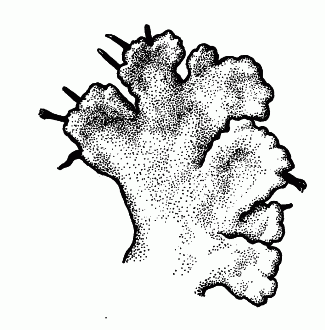Click on the image below to view an
expanded illustration for this species.

|
General:
Common Name: The Rosette Lichens. Describes the centrifugal growth form characteristic of many of the species.
Small to occasionally medium stratified foliose lichens, corticate above and below, sorediate or isidiate or not, lobes closely appressed to loosely attached, elongate-linear to elongate, averaging to 0.5–2 (–3) mm wide, thin. Upper surface usually pale whitish grey, rarely darker, K+ yellow, white-pruinose or white-spotted, dull. Lower surface pale to blackish, dull, bearing scattered, short, simple rhizines. Medulla white. Photobiont green.
Apothecia located over upper surface, disc white-pruinose to black; spores 2-celled, ellipsoid, brown, 8 per ascus.
Over acid or especially calcium-rich substrates, including rock, soil, duff, bark and bone.
Notes: Thirty species of Physcia are reported for North America and 11 of these are known to occur in B.C. Physcia has been subdivided into several segregate genera, including Phaeophyscia and Physconia.
Species description:
Lobe margins lacking cilia (Note: marginal rhizines may occur in some species, but these average to less than 0.8 mm long); lobe tips appressed AND
Thallus lacking soredia, isidia and lobules AND
Upper surface distinctly white-pruinose throughout, pale, lacking distinct whitespotting; over rock (rare over bark); semi-arid intermontane; medulla K- or occasionally K+ dingy pink
Comments:
Specimens having a K+ finally pinkish medullary reaction may be referred to P. magnussonii Frey.
Reactions:
Cortex K+ yellow.
Contents:
Atranorin.
Source: Lichens of British Columbia |
